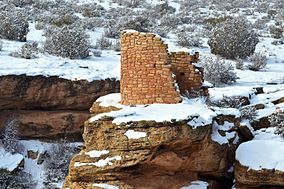Hovenweep National Monument
| Hovenweep National Monument | |
|---|---|
|
IUCN category V (protected landscape/seascape)
|
|

Horseshoe Tower in the snow
|
|
| Location | Montezuma County, Colorado & San Juan County, Utah, USA |
| Nearest city | Bluff, Utah, Blanding, Utah |
| Coordinates | 37°23′2″N 109°4′38″W / 37.38389°N 109.07722°WCoordinates: 37°23′2″N 109°4′38″W / 37.38389°N 109.07722°W |
| Area | 784 acres (317 ha) |
| Created | March 2, 1923 |
| Visitors | 25,858 (in 2011) |
| Governing body | U.S. National Park Service |
| Website | Hovenweep National Monument |
Hovenweep National Monument is located on land in southwestern Colorado and southeastern Utah, between Cortez, Colorado and Blanding, Utah on the Cajon Mesa of the Great Sage Plain. Shallow tributaries run through the wide and deep canyons into the San Juan River.
Although Hovenweep National Monument is largely known for the six groups of Ancestral Puebloan villages, there is evidence of occupation by hunter-gatherers from 8,000 to 6,000 B.C. until about AD 200. Later, a succession of early puebloan cultures settled in the area and remained until the 14th century.
Hovenweep became a National Monument in 1923 and is administered by the National Park Service. In July 2014, the International Dark-Sky Association designated Hovenweep an International Dark Sky Park.
Evidence from the area indicates that there were Paleo-Indians and people of the Archaic period. During the transitional period from a traditional hunter-gatherer society to pueblo people, there were several distinct cultural changes:
Early hunters
Late Basketmaker II Era AD 50 to 500
Basketmaker III Era 500 to 750
Pueblo I Era 750 to 900
Pueblo II Era – 900–1150
Pueblo III Era – 1150–1350
...
Wikipedia

